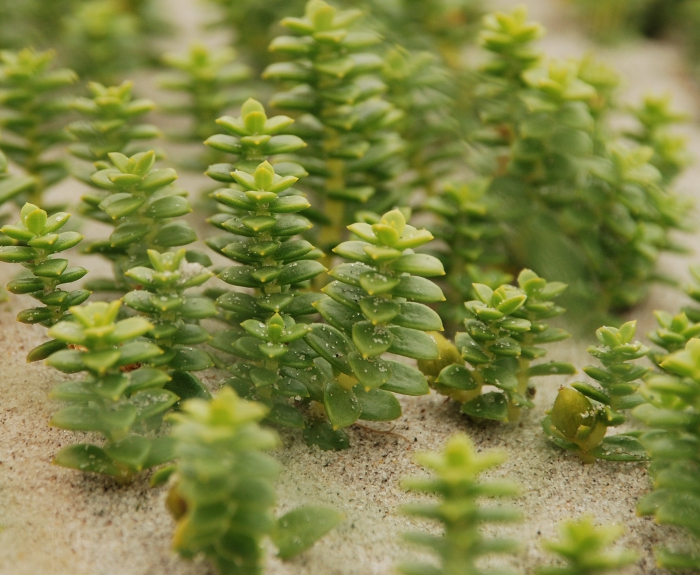Honckenya
|
Family: Caryophyllaceae |
Herbs, perennial, forming large mats or clumps by leafy rhizomes; rhizomes fleshy, often with prominent nodal buds and small membranous leaves. Taproots slender. Stems prostrate to decumbent, flowering stems ascending or weakly erect, simple or branched, terete or weakly 4-angled. Leaves not basally connate, sessile; blade 1-veined or obscurely so, usually elliptic to ovate, less commonly lanceolate to oblanceolate, obovate, or broadly elliptic, succulent, apex acute to acuminate or apiculate. Inflorescences terminal, open, leafy, 1-6-flowered cymes or axillary and flowers solitary; bracts paired, foliaceous. Pedicels erect. Flowers functionally unisexual or, occasionally, staminate plants also with some bisexual; perianth and androecium subperigynous; hypanthium minimal; sepals 5(-6), distinct, green, narrowly ovate to elliptic, 3.5-7 mm, herbaceous, margins pale, scarious, apex obtuse or acute to apiculate, not hooded; petals absent or 5(-6), white, base clawed, blade apex emarginate; nectaries at base of filaments opposite sepals enlarged on both sides of filament, slightly reduced in pistillate flowers; stamens 10, fertile in staminate flowers, fewer or abortive in pistillate flowers, arising from rim of very brief hypanthium disc; filaments distinct; staminodes absent; styles (2-)3-5(-6), filiform, 1-2 mm, shorter and erect in staminate flowers, glabrous proximally; stigmas (2-)3-5(-6), linear along adaxial surface of styles, minutely papillate (30×). Capsules globose, inflated, opening by 3 spreading valves; carpophore absent. Seeds 3-15, reddish brown to dark reddish or yellowish brown, narrowly to broadly obovate, laterally compressed, smooth to minutely papillate, marginal wing absent, appendage absent. x = 15. Fls solitary in the forks of the stem or in leafy terminal cymes, usually functionally unisexual; sep 5; pet 5; stamens normally 10; staminal disk conspicuous; styles (2)3-5(6); ovary usually 3-5-locular, but the capsule unilocular; seeds few, large, pyriform, basally rostrate; fleshy, glabrous perennials with entire, exstipulate lvs. 2, mostly cool N. Hemisphere. Gleason, Henry A. & Cronquist, Arthur J. 1991. Manual of vascular plants of northeastern United States and adjacent Canada. lxxv + 910 pp. ©The New York Botanical Garden. All rights reserved. Used by permission. |

